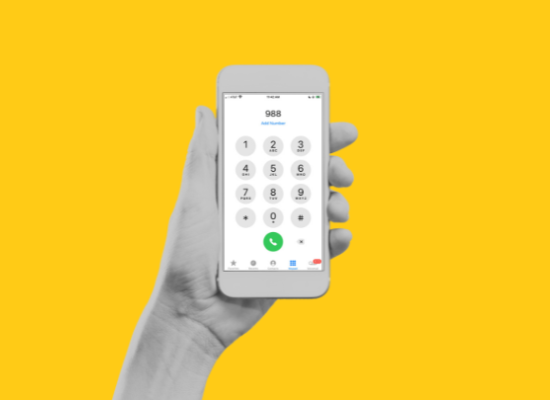
Stephanie Hepburn is a writer in New Orleans. She is the editor in chief of #CrisisTalk. You can reach her at .
There’s been much guesswork in determining the call volume 988 will experience, especially calls it could divert from 911. Americans make 240 million 911 calls per year, and behavioral health experts believe 988 could deflect at least 10%. This estimate comes, in part, from a Treatment Advocacy Center report highlighting that law enforcement spent an average of 10% of their total budgets in 2017 responding to and transporting people with mental illness. Some communities have also thoroughly analyzed their local 911 call center data, revealing that the number of calls suitable for diversion might be closer to 20%, including behavioral health and quality of life calls. However, Dia Gainor points out that most estimates haven’t included data from NEMSIS, the national EMS information system. “Communities could use the database,” she says, “to quickly determine behavioral health call volume in their county, surrounding counties, or the entire state.” Gainor is the executive director of the National Association of State EMS Officials.
As states prepare for the launch of 988—the three-digit number for mental health, substance use, and behavioral health crises that telecom companies must direct to the National Suicide Prevention Lifeline by July 16, 2022, leaders have been candid about the challenges they face trying to determine behavioral health and quality of life calls 911 call centers and other public safety answering points (often known as PSAPs) receive. This is in large part because there’s insufficient call code standardization. Further complicating the situation is that most 911 and non-emergency calls for these types of crises are made by third parties who often don’t know what the person they’re calling about is experiencing but share with authorities their perceptions, which are subjective and easily influenced by the caller’s biases.
The lack of standardization and feedback loops has misled researchers to estimate that mental health calls are just a tiny portion of 911 calls. For example, Cynthia Lum, a professor and criminologist at George Mason University’s Center for Evidence-Based Crime Policy, and her co-researchers have analyzed over four million 911 calls at nine agencies across the United States. They’ve concluded that, on average, only 1.3% of calls—and no more than 4% at any of the agencies—were related to mental health concerns. To standardize the nine agencies’ computer-aided dispatch (CAD) data, the researchers created general categories: disorder, domestic-related, interpersonal-other, property, medical, mental, missing persons, suspicions, and vice. While acknowledging that some people argue mental health calls might not appear as such, the authors state that systematic observations suggest “misclassification is not as large as believed.”
The problem is that call classification codes are both over- and under-specific. For instance, Dr. Rebecca Neusteter, executive director at University of Chicago’s Health Lab, worked in a jurisdiction in New York with 150 call codes. Yet, the most often used call code was “other.”
A study analyzing 3.4 million 911 calls in the Atlanta metropolitan area revealed that behavioral health and quality of life calls were often coded as “suspicious person” (24.6%), “directed patrol” (21%), “criminal trespass” (18.9%), or “street/sidewalk hazard” (12.6%). None were coded as mental or behavioral health. Still, vague call code classification and a lack of a feedback loop to determine whether call codes matched the crisis are only part of the problem. A multicity 911 analysis conducted by Dr. Neusteter and her former colleagues at the Vera Institute of Justice revealed that call takers were unlikely to classify calls the same way.
Gainor points out that NEMSIS codes are more specific and based on EMS activations, not just dispatch from a 911 call center. “An activation,” she says, “is any communication that initiates an ambulance response.” Not all 911 calls result in an ambulance dispatch, and not all ambulance calls come from 911 dispatch. A quick look at the national database’s weekly report reveals codes for anxiety, major depression, suicidal ideation, opioid-related disorders, poisoning by (and adverse effects of) opioid-related drugs, alcohol-related disorders, and toxic effects of alcohol. While EMS dispatchers determine the “reason for dispatch,” patient care reports in the system provide additional information like clinical findings and treatment at the scene of the emergency. If there’s a disconnect between “reason for dispatch” and “clinical findings,” a local ambulance service’s quality improvement program can use the database to run comparisons. Some EMS-behavioral health partnerships at 911 call centers are also creating a seamless feedback loop on calls and codes. For instance, Austin has integrated Expanded Mobile Crisis Outreach Team (EMCOT) clinicians on the city’s 911 call center floor. The team does monthly reviews with the Austin Police Department on call code accuracy to determine calls that should have been coded as mental health but weren’t. They also submit regular weekly reports to EMS so that their quality assurance can similarly review calls.
Because NEMSIS weekly data releases compare each week with that of the previous three years, communities can quickly identify trends. For example, mental-behavioral EMS activations during 2020 and 2021 hover far above those in 2018 and 2019. “We’ve seen large spikes in ambulance service usage during the pandemic,” says Gainor. This could be because of facility closures or lessened capacity during Covid but also patient preference. “Having care come to the person in need,” she says, “instead of going to a hospital surging with Covid patients is likely appealing.” Also, patients can refuse EMS transport, especially when there’s no law enforcement intervention.
A look at the annual 2020 data reveals that behavioral health was the primary impression—the reason for the medical encounter—in at least 12% of the services’ 33,844,754 activations. (The annual report has not yet been publicly released.) However, determining what other activations had a behavioral health nexus, primary or secondary, is less clear. Those labeled as “strange and inexplicable behavior” are likely—as with law enforcement codes—to involve behavioral health, but not necessarily. Gainor says figuring out which impressions are behavioral health is even more cumbersome because EMS conforms to healthcare International Classification of Diseases (ICD) numbers, resulting in a long list of specific and ambiguous options. Another hurdle is that EMS providers come on the scene when the person is already in crisis, so they’re often piecing together information after the fact. For example, although there are many poisoning ICD numbers to choose from, if EMS personnel don’t know what a person experiencing a substance use crisis took, they have to select a nonspecific impression like “poisoning by other drugs, medicaments, and biological substances, undetermined.”
A more exact estimate would depend on closer collaboration between behavioral health and EMS—though, notes Gainor, the availability and utility of these data may be an excellent starting point for partnership at the local and regional level. What’s incredibly appealing is that the database can give the behavioral health field immediate local, regional, and national figures. The NEMSIS database updates in real-time so long as states adopt the latest version, which is 3.5. “Any local EMS agencies and states with the current version have immediate access to the most up-to-date data,” says Gainor. When an EMT or paramedic closes an activation record, it’s in the state EMS office within seven minutes. “Communities can’t get these data anywhere else,” she says, “especially not as quickly.”
Gainor says automated mapping of NEMSIS data can help communities identify behavioral health trends and spikes. That’s precisely what the Overdose Detection Mapping Application Program, commonly called ODMAP, is doing to track suspected fatal and non-fatal overdoses in real-time in Florida and Maryland. The program, developed by the Washington/Baltimore High Intensity Drug Trafficking Area, uses a custom application programming interface to pull in data from multiple disciplines. “Historically, the program has depended on law enforcement to enter information every time they go out on a suspected overdose call,” she says. Syncing data from NEMSIS can give state, federal, local, and tribal jurisdictions a real-time picture of the opioid crisis. Similarly, communities could set up automatic processing interfaces through NEMSIS to map all behavioral health activations, electronically moving the data into a more extensive behavioral health repository. “If communities use the database, it will allow them to track their populations’ behavioral health needs,” she says. “The potential—not only for understanding crisis volume but also the implications for prevention—is huge.”









